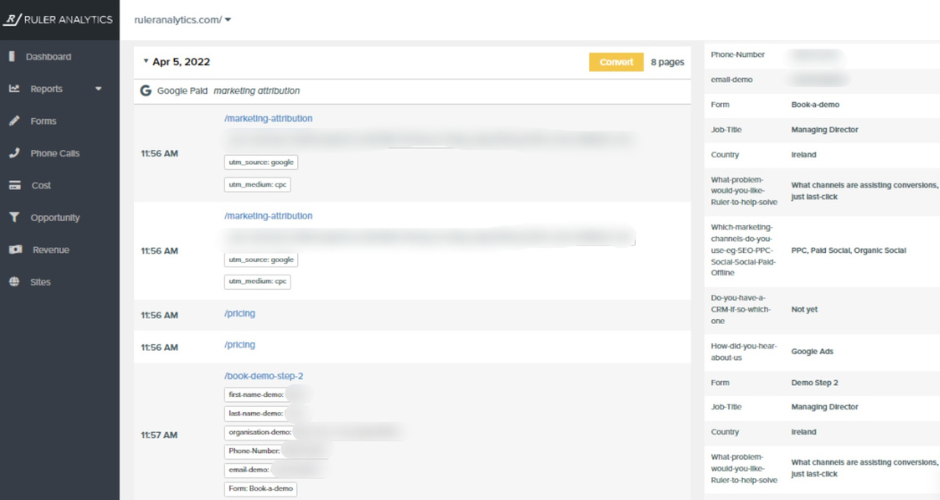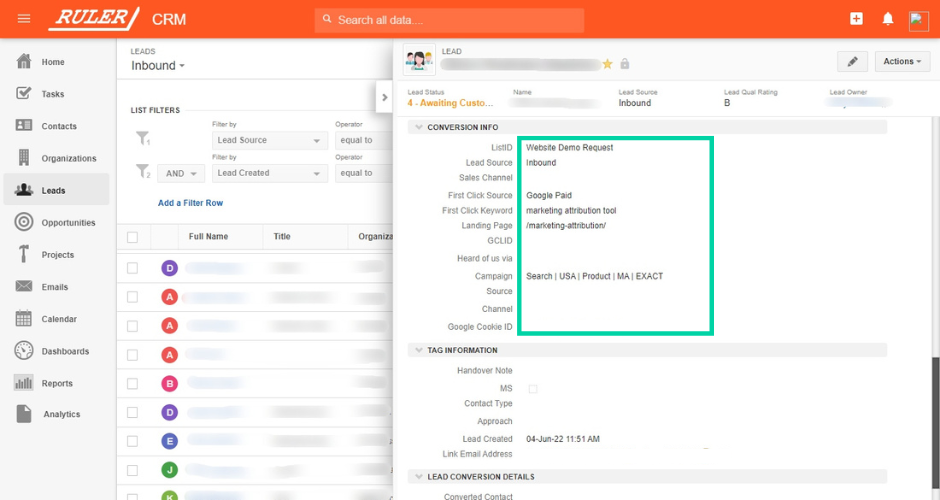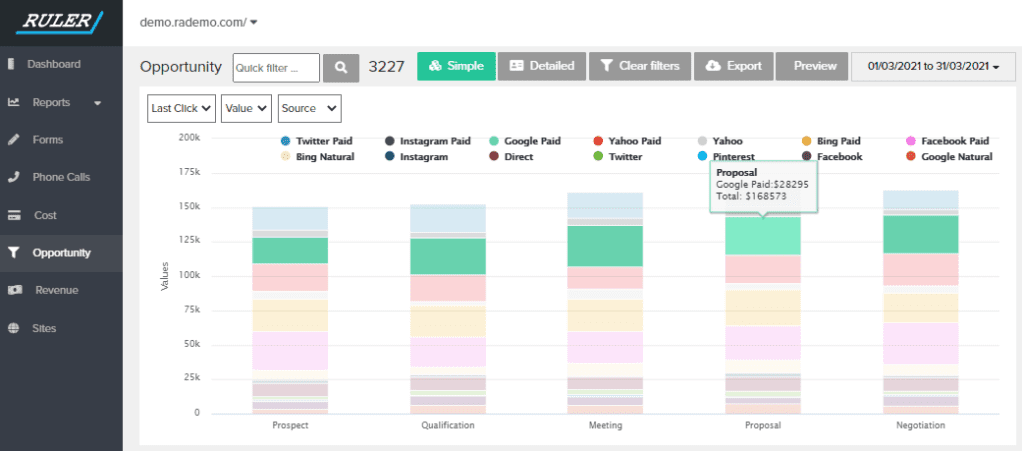We take a closer look at how closed-loop marketing works and show you how to successfully connect data from your marketing, sales and customer success platforms.
If you’ve landed on this blog post, you’re probably familiar with the concept of closed-loop marketing.
Chances are you’re here because you’re getting pressured by your business leaders to tie marketing activities to revenue and prove ROI.
We know the feeling. Trust us.
We’ve had tons of conversations with marketers about measuring marketing ROI. A lot of these marketers are now customers.
Don’t just take our word for it. We have plenty of content on how we’ve helped marketers track and improve their ROI.
But that’s enough about us.
You’re here because you want to learn about closed-loop marketing and how it can improve your digital performance.
So, let’s not waste any more time.
For this article, we’ll discuss:
💡 Pro Tip
Ruler makes the process of closed-loop marketing much more straightforward. It tracks data on a visitor level, allowing you to successfully attribute leads and marketing-generated revenue across multiple campaigns, ads, keywords and more.
Why you need Ruler’s closed-loop attribution and how to get it
Closed-loop marketing (or closed-loop reporting) allows you to pinpoint the lead generation techniques that drive the most or least revenue.

It is the process that connects your visitor, conversion and revenue data to calculate the exact return on investment of your marketing channels.
Related: Complete guide on how to calculate your marketing ROI
“Closing the loop” refers to connecting marketing with sales so that revenue is definitively and automatically matched to marketing activity to measure and optimise for better results.
When carried out properly, closed-loop marketing can offer you insights into different aspects of your sales and marketing funnel. That’s not all, closed-loop marketing can:
When it comes to decision-making, closed-loop data can help you make better choices.
You can see which campaigns and channels drive the most revenue in your reporting tools and optimise accordingly.
Let’s use Google Analytics, for example.
You log into Google Analytics, go to your acquisition report and see that Facebook have generated a similar number of leads for the same cost.

As Google Analytics can’t track lead quality on its own, your only option is to optimise your campaigns based on lead quantity.
Related: Lead tracking in Google Analytics
Say your CEO handed you more budget to increase revenue. Where would you invest it?
Based on the data in Google Analytics, you’d probably split it between Instagram and Facebook.
Now let’s apply closed-loop marketing data.

Big difference, right? The playing field has completely changed.
By adding closed-loop marketing data, we can now see that Facebook had the best impact on the business despite generating only four more leads than Instagram.
Not only can you optimise your decisions and investments backed by closed-loop data, but you can also…
To prove impact and make data-driven decisions, marketers will leverage revenue metrics. One obvious metric is ROI.
But tracking ROI isn’t an easy metric to track and measure.
Related: How to measure digital marketing ROI
Our data backs it up. 31% of marketers stated proving ROI was one of their biggest challenges.
As we touched on earlier, most marketers count on Google Analytics to measure marketing effectiveness.
90% of marketers say Google Analytics is their go-to tool for measuring web and marketing performance.
Honestly? We don’t blame them.
Google Analytics offers a variety of web metrics and customisable dimensions to measure marketing performance.
Related: 14 Google Analytics website metrics to measure
The problem with Google Analytics is that it doesn’t give you the data you need to track revenue growth and ROI. Two reasons why:
1. The data in Google Analytics is anonymous. There is no personally identifiable information collected. So you can’t see leads converting on your website and what they do after.
2. Even if Google Analytics could track anonymous visitors, the lookback window is limited to 90-days. If you sell high-value products or services, chances are your sales cycle is longer than three months. By relying on GA’s 90-day window, you’d miss out on useful data about your leads and customers.
But this is where closed-loop marketing comes in handy.
Closed-loop marketing adds an extra layer of data to your leads that traditional marketing analytics tools can’t provide alone.
It tracks visitors individually over multiple touchpoints across your entire sales cycle, allowing you to prove your ROI and show leaders how and why your marketing efforts are successful.
Don’t worry. We’ll show you how to get closed-loop marketing data and track visitors over multiple touchpoints shortly.
If closed-loop marketing is so powerful, why aren’t more marketers doing it? Mainly because they’re not built to do it successfully. Here are two reasons why:
Sales and marketing teams are disconnected from each other.
Related: Complete guide to sales and marketing alignment
Despite sharing the same end goal of generating revenue, sales and marketing are often considered two separate functions.
In most organisations, the marketing funnel starts with the awareness stage and ends when visitors convert into leads.
This is when the sales funnel kicks in and ends when an opportunity closes into a deal.
With both teams focusing on different stages of the funnel, data isn’t transferred between them.

As a result, sales doesn’t know what marketing activities generate the highest quality leads, and marketing doesn’t know what happens to leads once the sales team takes over.
Since sales are only capable of tracking half of the customer journey, they lack insight into the quality and buying intent of leads that drop into the pipeline.
Related: Guide to customer journey stages and tips on how to track them
As a result, they end up wasting time and energy on opportunities that will never convert.
It happens all too often. When asked to list the main factors that negatively impact the sales cycle, respondents ranked “having too many unqualified leads” as number one.
The best sales can offer marketing is feedback on the quality of leads.
And depending on whether they’ve had a good or bad month, it’ll either be:
But this doesn’t give marketing a lot to go off. How can marketing optimise investments and strategy when they can’t tell exactly what is and isn’t working?
They can’t.
Here’s the good news.
Sales and marketing teams can be aligned if they focus on the entire funnel together.
Now for the bad news.
Most companies have a data silo problem that stops them from getting a singular view of their customer touchpoints.
The stats back it up. 47% of companies said that their data is siloed and difficult to access. But why is it so hard to integrate data?
Related: How Ruler integrates your marketing, sales and customer data
Teams across all organisations are collecting data through a variety of applications, such as marketing analytics, CRM, customer success tools and others.
And each one of these tools is accessed and managed by different teams.
Take the marketing team, for example.
We’re already aware that most marketers are counting on Google Analytics to track leads and website performance. But chances are they’re using other ad platforms and marketing automation tools to track marketing effectiveness.
What about sales?
Well, unlike the marketing team, sales are mostly relying on data in their CRM. Who can blame them? CRM systems are the holy grail for sales teams. It holds every piece of information you have on opportunities and deals.
Now let’s not forget the customer success team.
After an opportunity converts into a deal, the customer success team will often take over. Once the customer success team has onboarded a customer, they’ll use subscription analytics platforms to track things like churn and retention.
That’s a lot of data to keep track of, right?
Clearly, each tool holds important information about leads and customers that can help you better adjust your business strategies.
However, because these tools each have a specific purpose and collect data differently, it’s hard to match it all up. And if you can’t piece it together, it’s impossible to gain a single source of truth on how leads and customers move through the funnel.
But this is where closed-loop marketing comes to the rescue.
Instead of telling you, let us show you how it can help…
Up to now, we’ve highlighted the importance of closed-loop marketing and its challenges.
We know that closed-loop data helps maximise marketing effectiveness by showing you which marketing efforts have the most meaningful impact on revenue and growth.
But how do you actually “close the loop”?
There are many companies out there telling how to do closed-loop marketing. You only need to search on Google to see it for yourself.
For us, we use the following steps to close the loop between our marketing, sales and customer data.
Honestly, speaking. To do closed-loop marketing successfully, you need to track and measure how individual visitors behave on your website.
Related: 11 website visitor tracking software and tools
By tracking visitors individually, you can monitor and measure the movements of specific users and track cross-channel journeys more cohesively.
As we’ve already highlighted, most web analytics tools let you track traffic sources such as PPC and referral, but they don’t let you focus on the specific steps of your visitors.
It probably doesn’t come as a surprise, but we use Ruler to track our anonymous website visitors.
For those that don’t know, Ruler is a marketing attribution tool that uses first-party cookies to identify your website users and tracks their unique journeys over multiple traffic sources, ads, keywords and more.
It basically isolates activity down to each specific user.
Take the screenshot below, for example.

In this specific journey, we can see that the user found our website by typing in the keyword “marketing attribution” in Google and converted into a lead by filling out a form.
If we were to rely on the data in google analytics, all we would see is a goal completion. We’d have no insight into this user’s journey or what keywords they used to find us.
Having complete access to this conversion and marketing touchpoint data allows us to:
💡 Pro Tip
Tracking customer interactions across multiple channels unlocks powerful insights that you can use to improve your customer experience and marketing efforts. See how Ruler can help you follow the complete lifecycle from awareness to loyalty.
How Ruler tracks full customer journeys
Next, we enrich our CRM with the marketing attribution data we captured in Ruler.
This allows our sales, marketing and customer success teams to gain a singular view of each lead and their marketing touchpoints.
At this point, you’re probably wondering why this is even necessary. After all, most CRMs offer built-in source fields that identify where your leads first originated.
While that’s true, CRMs will often merge all your digital channel activity into one lead source, such as “Web”.
Related: How to send lead source to your CRM
Seeing that a lead came from “Web” isn’t very helpful when “closing the loop”.
But that’s where Ruler steps in.
By integrating Ruler with our CRM, we can track every interaction a lead has had with our marketing campaigns before the conversion.
Take the screenshot below, for example.
This is what a lead record would look like in our CRM if we were to rely on Google Analytics.

You can see the generic contact details, but there’s nothing about where the lead came from or what ads they engaged with before completing a conversion.
Now let’s apply Ruler’s data.

Without Ruler’s data, we’d have no way to attribute this lead back to our PPC campaign.
We would be lost. Luckily that’s not the case.
Naturally, leads will progress through the sales cycle, going from a simple contact to a fully qualified sales opportunity.
As leads move from one stage to another, Ruler will keep a record of any changes in its dashboard.
This allows us to spot any bottlenecks in advance and take decisive action immediately.
Take the screenshot below, for example.

Here Ruler is providing us with information at different stages of the sales pipeline.
As you can see in the example, Google Ads is responsible for driving £28,295 to the proposal stage, whereas Google Organic has only added £7,695.
Based on this data, we could potentially allocate more spend to Google Ads to ensure that there are enough leads in the pipeline for sales to close into deals.
…And the loop is finally closed.
When an opportunity eventually converts into a deal, Ruler will utilise a pre-built integration to fire conversion and revenue data to its dashboard and your other favourite marketing apps.
Ruler will scrape the revenue from your CRM and share it with apps like Google Ads, Facebook Business Manager and Google Analytics.
Related: How Ruler enriches Google Analytics with attribution data
This allows the marketing teams to build reports showing exact values for marketing-generated revenue.
Take our ad performance report, for example.
Note: The numbers in this example are fictitious and are only used here as an illustration.

Above is a screenshot of our paid report. We’ve exported campaign data from our Google Ads account and put it into a Google Sheet. Alongside each keyword, we’ve added the number of clicks, conversions and total cost per lead.
Thanks to Ruler’s attribution data, we’re able to assign specific opportunities and revenue back to each campaign.
Not bad, right?
Well, Ruler doesn’t just stop at your marketing and sales apps. It also integrates with your revenue and subscription tools.
So you can see exactly which marketing and sales efforts have the greatest impact on customer lifetime value and churn.
💡 Pro Tip
We have a full case study on how we use Ruler and ChartMogul to close the loop between marketing and customer revenue.
How Ruler uses Chartmogul to close the loop
Closed-loop marketing allows you to focus on the channels and campaigns that matter most to your business.
When you know what lead sources drive the most revenue, you can stop wasting efforts on those that don’t perform as well.
Using tools like Ruler, closed-loop marketing is something that modern-day companies can take full advantage of to help solve the disconnect between sales and marketing, improve customer acquisition and prove marketing’s impact on revenue growth.
If you want to see the closed-loop marketing attribution model in action, then book a demo today.
Our experts will run you through how the platform works, and how you can use it to prove your marketing ROI and optimise your marketing efforts.
